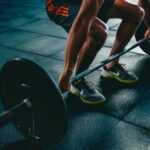The back and the entire spine, as well as all possible ailments such as cervical osteoarthritis, is one of the most sensitive parts of our entire body. In all the actions of our daily life, the entire posterior part intervenes. Therefore, exercising it and keeping it in a good level of health is presented as essential. One of the best methods available is the performance of Knapp exercises.

The complexity of the spine
It is impossible to understand the importance of these routines without understanding the complexity of the human backbone. The spine is made up of no more and no less than 33 vertebrae separated by intervertebral discs. Without the spine it is impossible for any mammal to maintain balance and move upright. In addition, it also acts as a protector of the spinal cord, so its importance in the human body is paramount.
The 33 vertebrae are divided into five different groups made up of seven cervical, 12 dorsal, five lumbar, five sacral and four coccyges’. Between each of these vertebrae we can find soft cartilage discs that act as a shock absorber and allow the vertebrae to move. The core also allows you to strengthen the spine. All the abdominal muscles support the back with the help of the rest of the muscles and ligaments.
Many may wonder what a healthy back is. Basically it is one that is completely aligned and with strong muscles that is capable of preventing muscle contractures. Physical exercise is essential to strengthen the back. When you do not play sports, the abdominal muscles and, consequently, those of the back weaken, making it easier for the spine to adopt a bad posture that can end up being a problem. One of the most common medical conditions is scoliosis, one of the main deviations that the spine can suffer.
What are Knapp exercises?
This type of exercises emerged at the beginning of the 20th century, developed by Dr. Knapp. Basing his studies on the observation of quadruped animals (those that use all four limbs to move), which were characterized by having a flexed body position, this German surgeon found that these types of animals never suffered from spinal problems. Scoliosis, that is, spinal deviation, was practically non-existent in this type of living being.
From this discovery, Rudolf Knapp concluded that the normal position of humans is the main cause of so-called spinal column problems. The pressure exerted by the force of gravity on the entire spine facilitates the imbalance of the entire spinal static part. His patients suffered from scoliosis, kyphosis, rot scoliosis, hype lordosis, and radiculopathy and chest deformities, among others. Thus his method had multiple benefits. In the lord tic areas, the spine has a greater range of motion and amplitude, the rib cage has greater freedom to expand and contract on all fours, and there is a greater constant relationship between the inclination of the entire trunk and the curvature of the spine.
From here, the German doctor developed his own method, which includes numerous exercises to correct this type of problem. All his correction movements of him are based on placing the patient in a crawling position, as if it were a quadruped animal. Thus, what is known today as functional physiotherapy was born. Knapp exercises are intended to restore mobility to the spine, while maintaining and improving its flexibility. By practicing these exercises for two hours a day, the muscles, bones and ligaments in the area were strengthened.
Benefits of this type of exercises for the back
The implementation of Knapp exercises has numerous benefits for the spine. The most prominent are the following:
- It improves the health of the back which contributes to a better quality of the patient in his day to day.
- Reduces the possibility of injuries to the spine and the possibility of suffering any type of lumbago.
- Gravity is removed from the column and greater stability is achieved
- Corrects postural problems and makes it easier to carry weights as simple as shopping bags in a mall
- Allows the performance of fitness exercises in which the dorsal muscles of the back work
- It allows adopting a more active lifestyle from the practice of sports and, at the same time, less sedentary.
- You gain in flexibility, strength and elongation of the entire part of the spine that is worked.
These types of exercises stretch the concave side of the spine and strengthen the entire convex side. The entire concave part corrects all your contractures, while the other part of the back is strengthened by gaining strength and flexibility. Previously, to carry out this type of practice, it is necessary to make sure that there is a good isogenic state in the working muscles. These are the spinal, intrascapular, and abdominal. Obviously, the results depend on the intensity, the cure and the regularity with which all the exercises are performed.
How to perform Knapp exercises
These types of exercises are divided into different types, depending on the objective that the patient has when starting therapy with their physiotherapist. Starting from the initial position in a quadruped form, ordinations and kyphotizations are performed. In the high ordinations, the entire dorsal and lumbar part is worked from supporting the palms of the hands on the knees and raising the chest. On the other hand, in low ordinations, the patient rests his elbows on his knees and not his hands from her. It is more intended for the cervical and dorsal. On the other hand, high kyphotizations see how the patient curves his spine forward after resting his hands on his knees, having an impact on the upper part of the dorsal. In low cifotizations the same exercise is performed supporting the elbows and influencing the lower part of the spine and the dorsal.
The Knapp method is made up of nine exercises. Of these nine, six are stretching and the remaining three are ambulation. To achieve these benefits, it is necessary to be regular and constant in the practice of the different Knapp exercise positions that you will learn about below. The low position consists of sinking the shoulder blades between the two forearms, to adopt a posture in the form of kyphosis. The last, between D1 and D4, can be mobilized while the hip is stabilized. The movement opposite to the curvature is achieved, while with the head it is possible to inhibit. In parallel, the so-called semi-low position can also be adopted.In this, the shoulder girdle is located horizontally at the height of the arms. Maintaining the position of kyphosis, the D5 and D7 dorsal are incised more selectively.
Within the inventory of exercises offered by Dr. Knapp there are also the semi-upright and upright positions. In the first, the body has the support of the knees and the fists, placing the spine with a movement in lordships that descends towards the dorsal D10, D12 and L1, achieving a totally straight position in kyphosis. The movement made by the spine is totally contrary to scoliosis, improving the curvature of the back. On the other hand, in the upright position, the exercise affects the L1 and L3 dorsal, achieving the same type of position in kyphosis. In the inverted position, finally, the patient does not use the hands that are kept crossed behind.Pulling the back slightly forward achieves a lordships movement located in the last L4-S1.
In addition, there is also what is known as the Knapp march... The usual walk is performed for those patients suffering from scoliosis C and begins with a position with opposite arms and legs. Extending the left upper limb and right lower limb corrects the dorsal and lumbar curvature from the extension of two limbs that are balanced with the rest. The amble gait, on the other hand, is done with the arms and legs on the same side. It is indicated for those who suffer from combined or S scoliosis. The right upper limb is advanced until the left homebody reaches its height. Those patients who suffer from hyper kyphosis or hype lordosis can walk alternately or with homologous limbs. The two upper limbs are advanced and, behind them, the two lower limbs.
However, the debate about the effectiveness of Knapp exercises has been constant in recent years. The main argument against its realization is its age, since it has more than a century of history behind it, in addition to the great difficulty of execution that some of the majority positions have. Despite everything, new techniques have emerged and it continues to be one of the main references in the large physiotherapy clinics worldwide and most recommended for all patients.
















